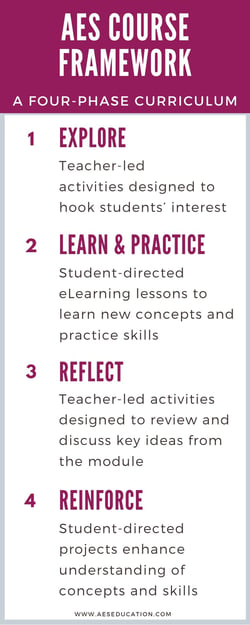Health Science | National Healthcareer Association (NHA) | Phlebotomy
How to Use HealthCenter21 in a Phlebotomy Technician Course
Betty Jean is detail-oriented and pays attention to how the smallest details can affect the big picture. Her passion is to provide error-free curriculum to our teachers so they can spend time pursuing their own passions.
As a CTE health science teacher, your curriculum ranges from health science foundations to certification-focused topics.
While introductory healthcare classes have many options available, it’s challenging to find age-appropriate resources for courses focused on specific careers, like phlebotomy technicians.
While HealthCenter21 isn’t a full phlebotomy technician curriculum, many teachers use it as a supplement to teach foundational skills and concepts.
In this article, you’ll discover which HealthCenter21 learning modules we recommend you use as a supplement for phlebotomy technician classes.
Before getting into the details, it’s essential to understand how HealthCenter21 is structured.
"HealthCenter21 is a great asset for the Certified Phlebotomy Technician (CPT) exam. In fact, my past students told me that the AES course for Phlebotomy helped more for passing their certification exam than the certification preparation materials."
Regina Jackson, Health Science Instructor
DeBakey High School for Health Professions, TX
How Is the HealthCenter21 Curriculum Structured?
HealthCenter21 is a digital curriculum with more than 1,000 curriculum hours of content organized into learning modules.
Each module focuses on an overarching healthcare topic and presents information according to our four-phase curriculum framework.
The four phases of the HealthCenter21 curriculum are:
- Explore
- Learn & Practice
- Reflect
- Reinforce
The Explore Phase includes teacher-led activities designed to hook your students’ interest. These activities get your students thinking and prime them for learning new concepts and skills in the later phases of the module.
The Learn & Practice Phase has teacher resources and student-directed eLearning lessons to help students learn new concepts and skills. This phase is where the bulk of student learning occurs and where you’ll find most of the curriculum coverage.
The Reflect Phase includes teacher-led activities designed to review and discuss key ideas from the eLearning lessons. This phase helps students connect concepts they just learned to their existing knowledge and experience. The activities help your students form long-lasting information retention.
The Reinforce Phase is made of student-directed projects to enhance the understanding of concepts and skills further. During this phase, students work independently or in groups to complete projects that require the application of the concepts learned from the module.
Overall, this four-phase learning plan maximizes your students’ understanding of the concepts and skills within each module.
But what’s the best way to leverage the four phases when using the modules as a supplement to your phlebotomy technician curriculum?
The best implementation for your pharmacy technician class will depend on your unique curriculum and students’ needs.
With HealthCenter21, we recommend a blended learning approach to balance student-led work, classroom activities, and your hands-on skills practices.
To learn how teachers like you implement these strategies, read this article: The AES Course Framework: A Four-Phase Curriculum.
Now that you understand the four-phase curriculum and how you can leverage it let’s discuss which HealthCenter21 modules work best in a phlebotomy technician course.
Which Curriculum Modules Should You Use in a Phlebotomy Technician Class?
The HealthCenter21 modules recommended for teaching a phlebotomy technician curriculum are:
- Anatomy and Physiology
- Bloodborne Pathogens
- CPR and Basic Life Support
- Emergency Care
- Infection Control
- Legal and Ethical Responsibilities
- Medical Office Assistant
- Personal Qualities
- Phlebotomy
- Safety Precautions
- Specimen Collection and Testing
This list includes the ten modules that will help your students learn the foundational knowledge and skills on the NHA CPT exam.
The order of these modules is not a recommended teaching sequence. Instead, these recommendations are a starting point to help you develop your syllabus and teaching plan when using HealthCenter21.
In some cases, your students may have worked through one or more of these modules in introductory health science courses. If that’s the case, you may decide only to use those modules as a refresher for your class.
Additionally, you may want to include other modules in your classes to provide further health science information to your students.
With that, let’s dive into what each module consists of and how they relate to teaching phlebotomy technician classes.
Anatomy and Physiology
The Anatomy and Physiology module provides an overview of the 12 human body systems and how they work together.
Students learn about structure, functions, diseases, disorders, homeostasis, and immunity.
Bloodborne Pathogens
The Bloodborne Pathogens module explores bloodborne pathogens and the effect the risk of infection has on healthcare practice.
In one activity, students research a bloodborne virus, syndrome, or community resource and create a brochure about the virus, syndrome, or community resource.
CPR and Basic Life Support
In the CPR and Basic Life Support module, students will learn all aspects of adult and pediatric BLS rescue, including concepts behind why specific procedures are used. This module gives students a strong foundation in CPR and BLS to help prepare them for BLS certification.
Emergency Care
The Emergency Care module provides an overview of emergency care as students learn to assess emergencies.
They also learn to react appropriately to bone and joint injuries, shock, open wounds, severe burns, foreign bodies, poisoning, heart attacks, strokes, diabetic reactions, seizures, convulsions, and heat and cold-related illnesses.
Infection Control
The Infection Control module provides an overview of the importance of protecting oneself and others from disease-causing microorganisms.
Students learn about microorganisms, asepsis, hand washing, basic equipment cleaning, autoclaving, personal protective equipment, sterile technique, and transmission-based precautions.
Legal and Ethical Responsibilities
The Legal and Ethical Responsibilities module provides students with the knowledge to make sound decisions when faced with workplace situations involving The Patient's Bill of Rights, Scope of Practice, tort law, contract law, confidentiality, privileged communication, and ethics.
Medical Office Assistant
The Medical Office Assistant module gives students an overview of the role and responsibilities of medical office occupations.
Topics include educational requirements, professionalism, personal appearance, teamwork, effective communication, HIPAA, and the legal issues that pertain to office personnel.
Personal Qualities
The Personal Qualities module provides an overview of the expected appearance and personal characteristics of successful health care workers as they understand the importance of communication, practice dealing with workplace situations, and evaluate workplace teams.
Phlebotomy
The Phlebotomy module provides an overview of how to collect blood specimens using venipuncture and fingerstick techniques.
Students learn about skin puncture, venipuncture, microhematocrit, hemoglobin, blood glucose, PKU tests, and more. You’ll also find a learning game that helps students practice the CLSI order of draw.
Safety Precautions
The Safety Precautions module provides an overview of safety techniques and the steps for greeting and identifying patients in a health care facility. Students use the Internet to research safety regulations from OSHA, the FDA, and the EPA and demonstrate how to report safety violations by filing an event report.
Specimen Collection and Testing
The Specimen Collection and Testing module provides an overview of the guidelines and safety precautions for handling specimens and CLIA-waived tests.
Students practice common procedures for collecting stool and urine specimens, strain urine, and perform common tests. They explore cultures, smears, and stains and practice taking throat, wound, and sputum specimens.
Prepare Your Students to Become Certified Phlebotomy Technicians with HealthCenter21
Overall, these modules are our best recommendations for using HealthCenter21 as a supplemental resource to teach phlebotomy technician classes and prepare students for the NHA CPT exam.
By incorporating HealthCenter21 with other phlebotomy lessons and activities, you’ll provide your students with a great blended learning experience.
For more detailed information on how you can use HealthCenter21 as a supplement and which NHA CPT exam topics it doesn’t cover, download your free guide:


